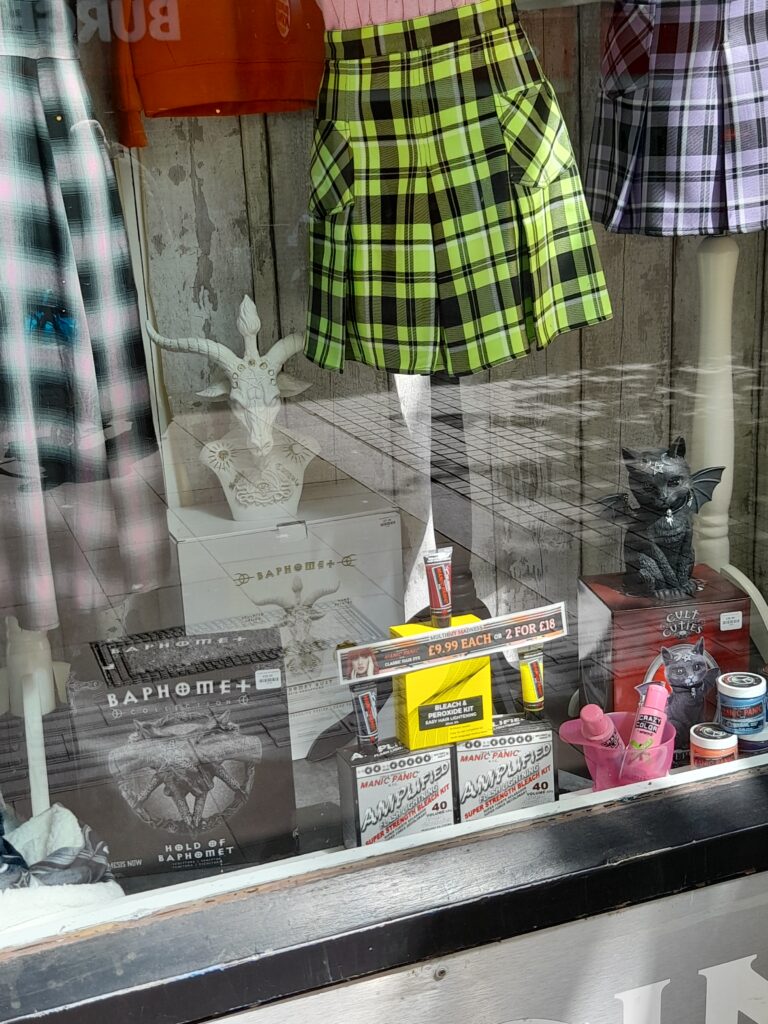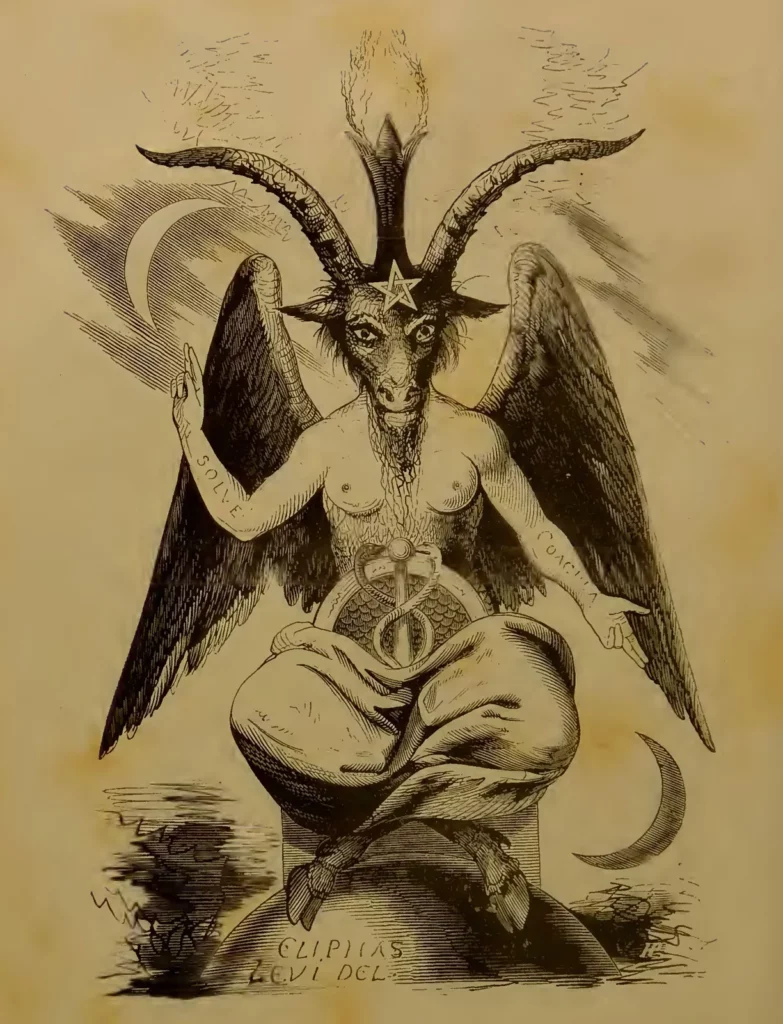
In Swansea recently I saw a window display built around the theme of death, and featuring prominently images of the goat god Baphomet. You can see the display in the pictures I took. I am sure many will have seen similar in their own towns and cities. It reminded me of how mindlessly people go after whatever image is fashionable, whatever takes their fancy, whatever they think might bring them luck.

The city is well supplied with New Age shops and market stalls. Just around the corner from this display a branch of Aura-The Witches Store Cupboard has opened selling rose skulls, pentagram and Ouija mugs, dream catchers, and pentagram shelving. You can see their merchandise here. Scrolling through their Facebook page we see the Buddha, a bony palmistry hand, and who should pop up again but Baphomet.
You may recall back in 2015 how the unveiling of a nine foot statue of Baphomet by a group calling itself the Satanic Temple sparked protests. Although they invited people to witness the unveiling they had to keep the location secret from everyone except those holding tickets.
The Satanic Temple apparently started as something of a joke, according to its founders, but quickly turned into a recognised religion. Which goes to show how these things can rapidly get out of hand, and there is no place for humour when it comes to the occult.
Baphomet
There are several etymologies for the name of Baphomet. It is said to have been the demon the Knights Templar worshipped, which charge, among many others, saw their order disbanded, its members hunted down, tortured and killed. Baphomet is believed to be a deformation of Mohammet, and the charge brought was that Templars had embraced Islam and devil worship.
These, clearly false, charges were brought by king Philip IV of France, who owed the Templars (early bankers) a lot of money and whose request to join their number was rejected. Confessions were obtained by torture and Philip found himself suddenly debt free. The original object of the Templars ‘worship’ was said to be a mummified head and nothing like the horned figure we think of today.

The familiar Pan-like goat headed figure we know today was the invention of Eliphas Levi (right), coming from his book ‘Transcendental Magic,’ 1854-56. The figure was based on the ram-headed Egyptian deity Banebdjedet, mistakenly referred to as the Goat of Mendes. The design of Devil cards in today’s Tarot packs are said to have been influenced by Levi’s illustration.
It might be argued, since Baphomet might simply be an invention designed to destroy the Templars in the early 12th century, and since the image we associate with him today was the 19th century invention of Eliphas Levi, there is nothing to be made of this, nothing to see here; but you would be mistaken.
Baphomet Eliphas and Aleister
Eliphas Levi (Real name Alphonse Louis Constant, 8 February 1810 – 31 May 1875) abandoned the Roman Catholic priesthood at the age of forty to become a ceremonial magician, transliterating his given names into Hebrew, thus arriving at Eliphas Levi. He influenced Helena Blavatsky and her Theosophical movement and was a great influence on later occultic groups, including the Hermetic Order of the Golden Dawn, as well as on Aleister Crowley.
Crowley was born into a wealthy family, former Quakers who joined the Plymouth Brethren. It was Crowley’s own mother who originally called him ‘The Beast.’ He rejected his Christian upbringing, pursuing occultic interests, and was initiated into the Hermetic Order of the Golden Dawn in November 1898. He later pursued his own occultic path, practising ritual magic. In the early 1900s he founded his own occultic, religious order, Thelema, adopting Eliphas Levi’s depiction of the Goat of Mendes, Baphomet, which became important in Crowley’s cosmology.
Baphomet has variously been associated with the Gnostics, the Templars, Freemasonry, the Sabbatic Goat of Eliphas Levi, The Illuminati, ancient Egypt and the Goat of Mendes, Pan, even the sect of Essenes who gave us the Dead Sea Scrolls. It is associated today with Paganism, Satanism, Tarot, the New Age and more. It features in popular fiction, such as the works of Dan Brown and James Blish, and sells in New Age shops, and teenage fashion outlets it turns out.
The point being, whether it has roots in a 12th century conspiracy against the Templars, whether its depiction was invented by Eliphas Levi pulling together an eclectic collection of symbols and images, including the increasingly misnomered ‘Goat of Mendes,’ it is what people do with it that matters. This is no better illustrated than by Eliphas Levi himself, then later Crowley, and later still Satanic sects and New Age practitioners. What matters even more is what God has to say on the matter and what the Bible can teach us.
You Shall be Holy
The theme of Leviticus is the holiness of God’s people. The language is of ritual cleanliness and holiness. Ritual and ethical cannot be separated, both pointing to God’s purpose in calling a people out of the world. This is how you approach a holy God, this is how a holy people live.
‘You shall be holy, for I the LORD your God am holy.’ (Lev.19:2)
‘You shall not do as they do in the land of Egypt, where you lived, and you shall not do as they do in the land of Canaan, to which I am bringing you. You shall not walk in their statutes. You shall follow my rules and keep my statutes and walk in them. I am the LORD your God’ (Lev.18:3/4 cf. v.24)
Cattle have been venerated and worshipped in many religions around the world and through history. The Apis Bull, worshipped by the Egyptians as the son of the major deity Hathor, was the model for the golden calf in the desert, a practise returned to by Jeroboam in the Northern kingdom (1 Kings 12:26-30). Goat demons, or goat gods, would have been very familiar to Israelites recently delivered from servitude in Egypt. Ellicot’s Commentary for English Readers explains:
‘And they shall no more offer their sacrifices unto devils.–The word (s?irim) here translated “devils,” literally denotes hairy or shaggy goats, and then goat-like deities, or demons. The Egyptians, and other nations of antiquity, worshipped goats as gods. Not only was there a celebrated temple in Thmuis, the capital of the Mendesian Nomos in Lower Egypt, dedicated to the goat-image Pan, whom they called Mendes, and worshipped as the oracle, and as the fertilising principle in nature, but they erected statues of him everywhere. Hence the Pan, Silenus, satyrs, fauns, and the woodland gods among the Greeks and Romans; and hence, too, the goat-like form of the devil, with a tail, horns, and cloven feet, which obtain in medieval Christianity, and which may still be seen in some European cities. The terror which the devil, appearing in this Pan-like form, created among those who were thought to have seen him, has given rise to our expression panic. This is the form of idolatrous worship which the Jews brought with them from Egypt, and to which reference is continually made.’
There is a deep and seriously troubling history to this goat image. In Leviticus we read:
‘If any one of the house of Israel kills an ox or a lamb or a goat in the camp, or kills it outside the camp, and does not bring it to the entrance of the tent of meeting to offer it as a gift to the Lord in front of the tabernacle of the Lord, blood-guilt shall be imputed to that man. He has shed blood, and that man shall be cut off from among his people. This is to the end that the people of Israel may bring their sacrifices that they sacrifice in the open field, that they may bring them to the Lord, to the priest at the entrance of the tent of meeting, and sacrifice them as sacrifices of peace offerings to the Lord. And the priest shall throw the blood on the altar of the Lord at the entrance of the tent of meeting and burn the fat for a pleasing aroma to the Lord. So they shall no more sacrifice their sacrifices to goat demons, after whom they whore.’ (17:3-7)
The significance of slaughtering animals outside the camp is found at the end of this passage. ‘So they shall no more sacrifice their sacrifices to goat demons, after whom they whore.’
This was an injunction against do-it-yourself spirituality (sound familiar?) practised away from the camp and the tabernacle. As Eric Tidball explains in his BST commentary on Leviticus, ‘Once people began to set up their own forms of sacrifice and perform them when, where and how they liked, elements of pagan worship from surrounding cultures would soon be imported to ‘improve’ the liturgy of Israel.’
Any Christian paying attention today sees and knows how difficult it can be to stand out, to go against the flow of the surrounding culture. Anyone who pays attention sees and knows how easily the world goes after the latest thing, like a social contagion, and understands how important it is to warn of the perils of unquestioningly following the culture. We know in the church today there are those who readily adopt and embrace those things of the world that God calls ‘abominable’. Moses warns:
“When the Lord your God cuts off before you the nations whom you go in to dispossess, and you dispossess them and dwell in their land, take care that you are not ensnared to follow them, after they have been destroyed before you, and that you do not enquire about their gods, saying, ‘How did these nations serve their gods?—that I also may do the same.’You shall not worship the Lord your God in that way, for every abominable thing that the Lord hates they have done for their gods, for they even burn their sons and their daughters in the fire to their gods.’ Deut.12:29-32
Paul warns:
‘For the time is coming when people will not endure sound teaching, but having itching ears they will accumulate for themselves teachers to suit their own passions, and will turn away from listening to the truth and wander off into myths.’ 2 Tim.4:3-4
Perhaps, like me, you have wondered how it was the people of God could have gone from so miraculous a deliverance from slavery to a golden calf, and goat demons outside the camp. Hundreds of years of cultural assimilation would have done it. A bad season, a barren womb, would have seen them turn to fertility and nature gods from habit, apprehension, and a complete lack of trust in the God of their so recent deliverance.
Writing about these things Paul warns:
‘Now these things took place as examples for us, that we might not desire evil as they did. Do not be idolaters as some of them were; as it is written, “The people sat down to eat and drink and rose up to play.”We must not indulge in sexual immorality as some of them did, and twenty-three thousand fell in a single day. We must not put Christ to the test, as some of them did and were destroyed by serpents,nor grumble, as some of them did and were destroyed by the Destroyer.Now these things happened to them as an example, but they were written down for our instruction, on whom the end of the ages has come. Therefore let anyone who thinks that he stands take heed lest he fall.’ 1 Cor.10:6-12
Social contexts, cultural norms, and polite company give us our idols. As Exodus 32:6 tells us of the golden calf incident, ‘The people sat down to eat and drink and rose up to play.’ We see it in people decorating their homes with protective charms like dream-catchers, lucky cats (Maneki-Neko), crystals, Buddhas, and Baphomet.
Charmed by an idea, drawn to a knick-knack for that space on a shelf, disarmed by the prospect of good fortune, the collecting of things begins, mixing cultural and religious images. But, as the song goes, ‘it’s not where you start it’s where you finish,’ and such things never finish well.
Further Reading:

